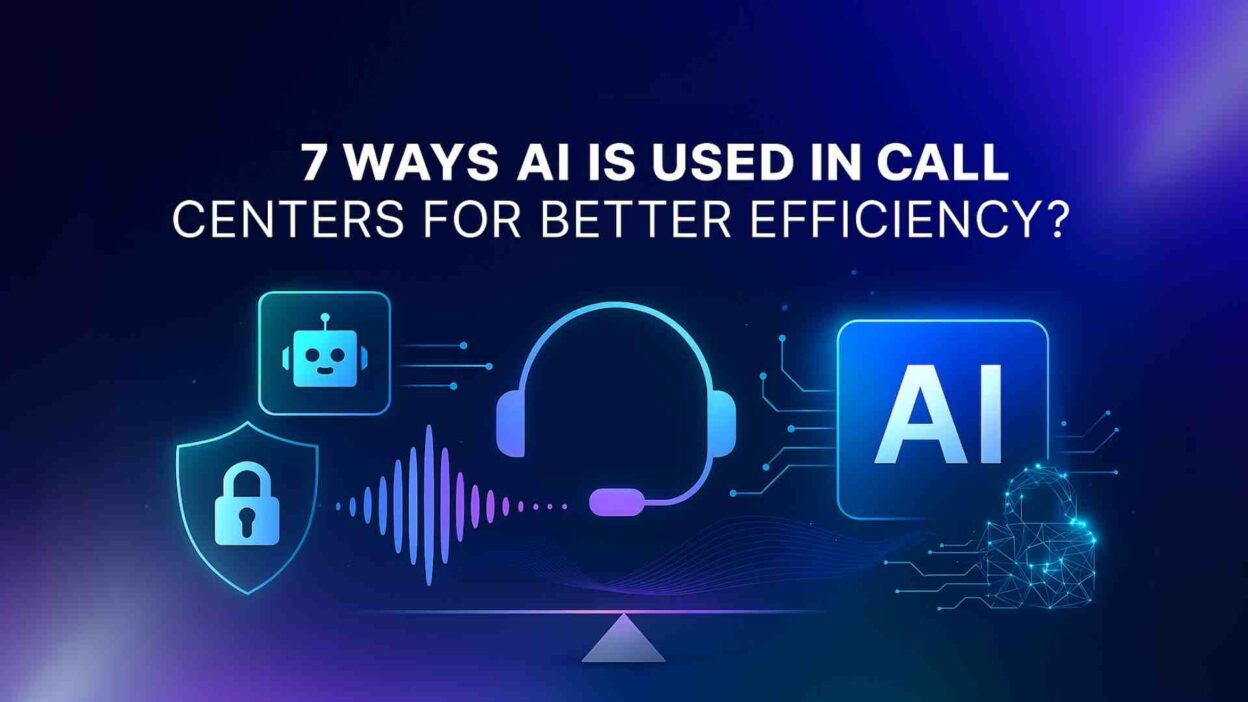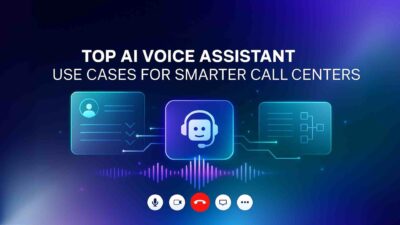TL;DR Call centers have evolved dramatically over the past decade. Modern technology transforms customer service operations in ways previously unimaginable. Understanding how AI is used in call centers helps businesses improve their customer experience while reducing operational costs.
Table of Contents
Artificial intelligence revolutionizes every aspect of call center operations. From automated responses to predictive analytics, AI tools enhance agent productivity and customer satisfaction. Companies worldwide implement these technologies to stay competitive in today’s demanding service landscape.
Customer expectations continue to rise as digital experiences become more sophisticated. Traditional call center approaches often fall short of meeting these heightened demands. AI-powered solutions bridge this gap by providing faster, more accurate, and personalized customer interactions.
This comprehensive guide explores seven key ways artificial intelligence transforms call center efficiency. Each method offers unique benefits while contributing to overall operational excellence. Your organization can implement these strategies to achieve measurable improvements in service quality and cost management.
Understanding AI in Modern Call Centers
Artificial intelligence encompasses various technologies that simulate human intelligence in call center environments. Machine learning algorithms analyze customer data to predict behavior patterns and preferences. Natural language processing enables systems to understand and respond to customer inquiries naturally.
Voice recognition technology converts spoken words into digital text for analysis and routing purposes. Computer vision analyzes visual elements from video calls and screen-sharing sessions. Robotic process automation handles repetitive tasks without human intervention.
Deep learning models improve continuously based on interaction data and outcomes. These systems become more accurate and efficient over time through experience. Neural networks process complex patterns in customer behavior that humans might miss.
Cloud-based AI platforms make advanced technologies accessible to organizations of all sizes. Small businesses can now afford enterprise-level AI capabilities through subscription services. Scalable solutions grow with your business needs without requiring massive upfront investments.
Integration capabilities allow AI systems to work seamlessly with existing call center infrastructure. Modern AI platforms connect with CRM systems, knowledge bases, and communication tools. This connectivity ensures data flows smoothly between all customer service touchpoints.
Intelligent Call Routing and Distribution
Smart routing systems analyze multiple data points to determine optimal agent assignments. Customer history, agent skills, current workload, and inquiry complexity all factor into routing decisions. This intelligent matching improves first-call resolution rates significantly.
Skill-based routing ensures customers connect with agents who possess relevant expertise for their specific needs. AI systems evaluate agent performance data and training records to make informed assignments. Specialized knowledge leads to faster problem resolution and higher customer satisfaction.
Priority routing identifies high-value customers and urgent issues requiring immediate attention. VIP customers receive faster service while critical problems get escalated appropriately. Revenue impact and customer lifetime value influence routing priorities automatically.
Predictive routing anticipates peak call volumes and adjusts staffing levels accordingly. Historical data patterns help forecast busy periods and required agent coverage. Proactive scheduling prevents long wait times during high-demand periods.
Geographic routing connects customers with local agents who understand regional preferences and regulations. Language preferences and cultural considerations improve communication effectiveness. Local expertise enhances customer comfort and trust in the service experience.
Queue management algorithms optimize wait times by balancing call distribution across available agents. Real-time monitoring adjusts routing rules based on current conditions and performance metrics. Dynamic optimization ensures efficient resource utilization throughout the day.
Automated Customer Service Chatbots
Conversational AI handles routine customer inquiries without requiring human agent intervention. Natural language understanding allows chatbots to interpret customer questions accurately. Pre-programmed responses provide instant answers to frequently asked questions.
Multi-channel chatbot deployment covers websites, mobile apps, social media platforms, and messaging services. Consistent responses across all channels maintain brand voice and service quality. Omnichannel integration provides seamless customer experiences regardless of contact method.
Context awareness enables chatbots to maintain conversation continuity across multiple interactions. Customer history and previous conversations inform current responses. Personalized interactions make customers feel valued and understood.
Escalation protocols seamlessly transfer complex issues to human agents when necessary. Smart handoff procedures provide agents with a complete conversation context. Smooth transitions prevent customers from repeating information they already provided.
Learning capabilities improve chatbot performance through continuous interaction analysis. Machine learning identifies gaps in knowledge and response accuracy. Regular updates expand chatbot capabilities and improve customer satisfaction scores.
Integration with knowledge bases ensures chatbots have access to current product information and policies. Real-time updates keep responses accurate and relevant. Automated content synchronization prevents outdated information from reaching customers.
Predictive Analytics for Workforce Management
Demand forecasting models predict call volumes based on historical patterns and external factors. Seasonal trends, marketing campaigns, and product launches all influence customer contact patterns. Accurate predictions enable proper staffing decisions and cost optimization.
Agent scheduling optimization balances service level targets with labor costs effectively. AI algorithms consider agent preferences, skills, and availability when creating schedules. Optimized scheduling reduces overtime costs while maintaining service quality standards.
Real-time adherence monitoring tracks agent compliance with scheduled activities and break times. Automated alerts notify supervisors when agents deviate from planned schedules. Immediate corrections prevent service level impacts and maintain operational efficiency.
Attrition prediction models identify agents at risk of leaving the organization. Early warning systems enable proactive retention efforts and succession planning. Reduced turnover saves training costs and maintains service consistency.
Performance forecasting anticipates individual agent productivity based on historical trends and current factors. Personalized coaching recommendations help agents improve their performance metrics. Targeted development efforts maximize return on training investments.
Capacity planning ensures adequate resources for projected business growth and seasonal variations. Long-term planning helps organizations make informed decisions about hiring and infrastructure investments. Strategic resource allocation supports business objectives and service commitments.
Sentiment Analysis and Emotional Intelligence
Real-time emotion detection analyzes customer voice patterns and word choices during conversations. Stress indicators and frustration levels trigger appropriate agent responses and supervisor alerts. Early intervention prevents customer dissatisfaction from escalating.
Conversation sentiment tracking provides insights into customer experience quality throughout interactions. Positive and negative sentiment patterns reveal training opportunities and process improvements. Sentiment trends inform strategic decisions about service delivery methods.
Agent coaching recommendations emerge from sentiment analysis of customer interactions. Specific feedback helps agents improve their communication skills and emotional intelligence. Targeted training programs address common sentiment-related challenges.
Customer satisfaction prediction models forecast likely outcomes based on conversation sentiment progression. Proactive interventions during negative sentiment periods can salvage difficult interactions. Predictive insights enable agents to adjust their approach before problems escalate.
Brand sentiment monitoring across all customer interactions provides valuable business intelligence. Overall sentiment trends indicate customer perception changes over time. Marketing and product teams use this information for strategic planning purposes.
Quality assurance enhancement through sentiment analysis provides objective evaluation criteria beyond traditional metrics. Emotional impact assessment complements traditional call scoring methods. Comprehensive evaluation improves coaching effectiveness and agent development.
Voice Analytics and Speech Recognition
Speech-to-text conversion enables real-time analysis of customer conversations without recording storage requirements. Live transcription supports compliance requirements while enabling immediate analysis. Text analysis tools extract insights from conversations as they occur.
Keyword spotting identifies specific terms and phrases that indicate customer needs or compliance requirements. Automated flagging ensures important information receives appropriate attention. Regulatory keyword monitoring helps maintain compliance with industry standards.
Agent compliance monitoring ensures adherence to scripts, disclosures, and regulatory requirements. Automated detection of missed disclosures triggers immediate coaching interventions. Compliance scoring provides an objective measurement of regulatory adherence.
Call summarization automatically generates detailed summaries of customer interactions for record-keeping purposes. Key points extraction reduces manual documentation time significantly. Standardized summaries improve information consistency and searchability.
Quality scoring automation evaluates calls against predefined criteria and standards. Objective scoring reduces supervisor workload while maintaining evaluation consistency. Automated feedback provides agents with immediate performance insights.
Accent and language detection routes customers to appropriate agents with matching communication capabilities. Improved communication reduces misunderstandings and increases customer satisfaction. Language matching enhances service quality for diverse customer populations.
Real-Time Agent Assistance and Coaching
Contextual guidance provides agents with relevant information and suggestions during active customer conversations. Knowledge base integration surfaces helpful articles and solutions automatically. Real-time support improves agent confidence and customer satisfaction.
Script recommendations suggest appropriate responses based on conversation context and customer profile. Dynamic scripting adapts to specific situations and customer needs. Personalized guidance improves interaction quality and consistency.
Next-best-action suggestions guide agents toward optimal resolution paths and upselling opportunities. AI algorithms analyze customer data to recommend the most appropriate actions. Revenue optimization occurs naturally through intelligent recommendations.
Compliance reminders alert agents to required disclosures and regulatory requirements during calls. Automated prompts ensure consistent adherence to legal and policy requirements. Risk mitigation protects organizations from compliance violations and penalties.
Performance coaching delivers immediate feedback and improvement suggestions during or immediately after customer interactions. Real-time coaching maximizes learning opportunities and skill development. Continuous improvement accelerates agent development and performance optimization.
Knowledge gap identification highlights areas where agents need additional training or information. Learning needs assessment enables targeted training program development. Personalized development plans improve individual agent effectiveness.
Process Automation and Workflow Optimization
Ticket creation and routing automation eliminates manual data entry and reduces processing time. Intelligent categorization ensures tickets reach appropriate resolution teams quickly. Automated workflows maintain consistent handling procedures across all interactions.
CRM integration synchronizes customer data across all systems automatically. Real-time updates ensure agents access current customer information during interactions. Data consistency improves service quality and reduces customer frustration.
Follow-up task automation schedules and executes post-call activities without manual intervention. Appointment scheduling, email sending, and case updates occur automatically. Workflow automation frees agents to focus on direct customer interactions.
Report generation automation produces performance metrics and analytics reports on scheduled intervals. Customizable dashboards provide real-time visibility into operational performance. Automated reporting reduces administrative overhead and improves decision-making speed.
Quality assurance workflows streamline evaluation processes and coaching delivery. Automated scoring and feedback distribution accelerate performance improvement cycles. Systematic quality management ensures consistent service standards.
Integration orchestration coordinates data flow between multiple systems and platforms seamlessly. API connections enable real-time information sharing across the technology stack. Unified data access improves agent efficiency and customer experience.
Measuring AI Implementation Success
Key performance indicators track the impact of AI implementation on call center operations. First-call resolution rates, average handle times, and customer satisfaction scores provide quantitative success measures. Regular monitoring ensures AI initiatives deliver expected benefits.
Return on investment calculations demonstrate the financial value of AI technology investments. Cost savings from automation and efficiency improvements offset implementation expenses. ROI analysis supports future AI investment decisions and budget planning.
Customer satisfaction improvements reflect the quality impact of AI-enhanced service delivery. Survey scores and feedback analysis reveal customer perception changes. Satisfaction trends validate AI implementation strategies and identify improvement opportunities.
Agent productivity metrics show how AI tools enhance human performance and efficiency. Call resolution rates, utilization percentages, and quality scores indicate productivity changes. Productivity improvements justify AI investments and guide optimization efforts.
Operational cost reductions demonstrate the financial benefits of AI automation and optimization. Labor cost savings, infrastructure efficiency gains, and process improvements contribute to overall cost reduction. Cost analysis supports business case development for expanded AI adoption.
Quality consistency measurements track service standardization improvements across all customer interactions. Variance reduction in service delivery indicates successful AI implementation. Consistent quality builds customer trust and brand reputation.
Common Implementation Challenges
Technology integration complexity requires careful planning and phased implementation approaches. Legacy system compatibility issues may necessitate infrastructure upgrades or workarounds. Technical expertise requirements may exceed internal capabilities and require external support.
Change management resistance from agents and supervisors can impede AI adoption success. Fear of job displacement and skepticism about technology effectiveness create implementation barriers. Comprehensive training and communication programs address resistance and build acceptance.
Data quality requirements for effective AI performance may exceed current data management capabilities. Incomplete or inaccurate data reduces AI effectiveness and decision quality. Data cleansing and standardization projects often precede successful AI implementations.
Cost considerations include initial implementation expenses and ongoing operational costs. Budget constraints may limit the scope or timeline of AI adoption initiatives. Financial planning must account for both direct costs and indirect resource requirements.
Vendor selection complexity arises from the numerous AI solution providers and technology options available. Evaluation criteria must balance functionality, cost, integration requirements, and vendor stability. Due diligence processes ensure optimal vendor partnership decisions.
Performance optimization requires continuous monitoring and adjustment of AI algorithms and parameters. Initial implementations rarely achieve optimal performance without ongoing refinement. Optimization processes require dedicated resources and technical expertise.
Future Trends in AI Call Center Technology
Conversational AI advancement will enable more natural and sophisticated customer interactions. Emotional intelligence capabilities will improve AI understanding of customer feelings and motivations. Advanced natural language processing will handle increasingly complex customer requests.
Omnichannel integration will provide seamless customer experiences across all communication channels. Voice, chat, email, social media, and video interactions will share context and history. Unified customer profiles will inform interactions regardless of contact method.
Predictive customer service will anticipate customer needs and proactively address potential issues. Behavioral analysis will identify customers likely to experience problems or require assistance. Proactive outreach will prevent problems and improve customer satisfaction.
Augmented reality integration will enhance agent capabilities through visual assistance and remote support. AR tools will enable agents to provide technical support and troubleshooting guidance more effectively. Visual communication will improve problem resolution speed and accuracy.
Hyper-personalization will customize every interaction based on individual customer preferences and history. AI will tailor communication style, channel preferences, and solution recommendations for each customer. Personalized experiences will differentiate brands in competitive markets.
Autonomous resolution capabilities will handle increasingly complex customer issues without human intervention. Advanced AI systems will resolve multi-step problems and make decisions within defined parameters. Human agents will focus on high-value and relationship-building activities.
Best Practices for AI Implementation
Pilot program development allows organizations to test AI capabilities on a limited scale before full deployment. Small-scale implementations provide learning opportunities and risk mitigation. Pilot results inform larger rollout strategies and optimization approaches.
Stakeholder engagement ensures buy-in from agents, supervisors, and management throughout the implementation process. Communication strategies address concerns and highlight benefits for all stakeholder groups. Engaged stakeholders contribute to implementation success and adoption rates.
Training program development prepares agents and supervisors for AI-enhanced operations. Comprehensive training covers technology usage, new processes, and performance expectations. Ongoing education ensures continued proficiency as AI capabilities evolve.
Performance monitoring establishes baseline metrics and tracks improvement progress throughout implementation. Regular assessment identifies successful elements and areas requiring adjustment. Data-driven optimization ensures maximum benefit realization from AI investments.
Vendor partnership management maintains productive relationships with AI solution providers. Clear expectations, regular communication, and performance accountability ensure vendor success. Strong partnerships facilitate ongoing support and technology evolution.
Continuous improvement processes ensure AI implementations evolve with business needs and technology capabilities. Regular reviews identify optimization opportunities and emerging requirements. Adaptive approaches maximize long-term value from AI investments.
Read More: Adding AI to Software with API Integration
Conclusion

Understanding how AI is used in call centers reveals tremendous opportunities for operational improvement and customer experience enhancement. These seven applications demonstrate AI’s transformative potential across all aspects of call center operations. Smart routing, chatbots, predictive analytics, sentiment analysis, voice analytics, real-time assistance, and process automation each contribute unique value.
Successful AI implementation requires careful planning, stakeholder engagement, and continuous optimization efforts. Organizations must balance technology capabilities with human expertise to achieve optimal results. The question of how AI is used in call centers continues to evolve as technology advances and customer expectations change.
Investment in AI call center technology provides measurable returns through improved efficiency, reduced costs, and enhanced customer satisfaction. Early adopters gain competitive advantages while building capabilities for future innovations. The strategic value of AI implementation extends beyond immediate operational benefits.
Future developments will expand AI capabilities and create new opportunities for call center optimization. Organizations that establish strong AI foundations today will be better positioned for tomorrow’s advancements. Understanding how AI is used in call centers becomes increasingly critical for business success.
The transformation of call center operations through AI represents a fundamental shift toward data-driven, customer-centric service delivery. Companies that embrace this transformation will lead their industries, while those that resist risk will face obsolescence. The time for AI adoption in call centers is now.





